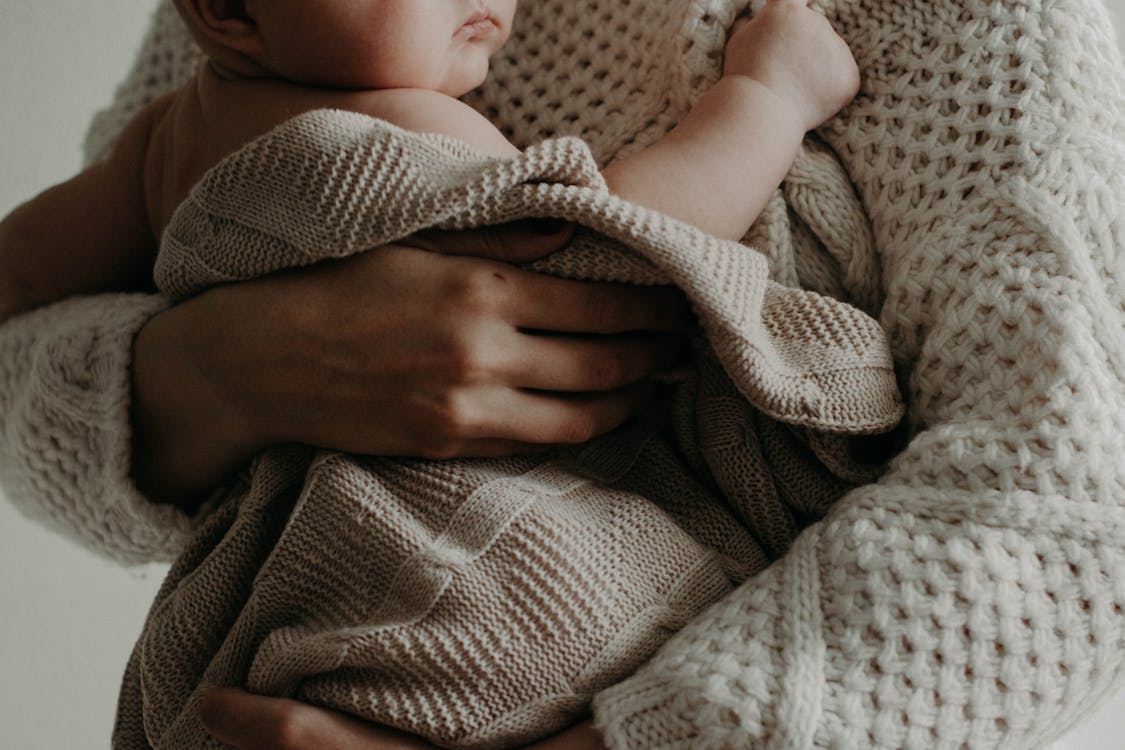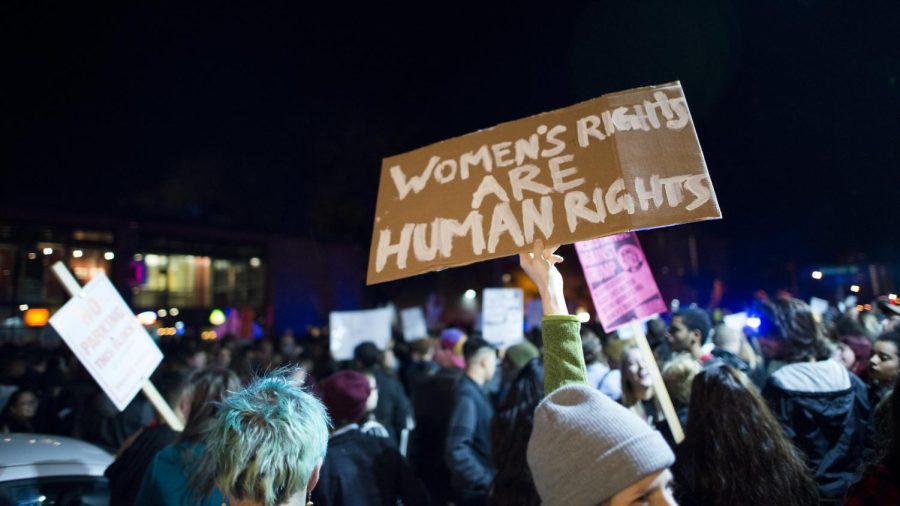Sexism Is Still Extremely Relevant In Today’s Society
Women’s History Month Entails Talking About Women’s Issues
Women’s Issues And Rights – Credit: “Women against Donald Trump” by Fibonacci Blue is licensed under CC BY 2.0.”
This article contains potentially triggering topics: assault, abuse, rape, and violence.
Please be aware of your mental state before reading and reach out to the appropriate source linked below the article.
Women have always struggled in life, throughout many generations. Past feminist laws, bills, and protests have improved women’s lives; but despite these improvements there are still many struggles that are endured in present times.
Occupational Issues
Historically, women weren’t able to have the same jobs as men. Now that is now a possibility, but there is still one issue with employment: there is a wage gap between the two genders. The Equal Pay Act of 1963 was meant to prevent any sort of unfairness between their payment, but as of today, women only make an average of 77 cents for every dollar a man will make. This wage gap becomes larger when looking into further minorities like Black women only making 58 cents for every dollar a white man makes. Some argue that this is because men work at higher positions, well that is just not the case. This data gathered by Elise Gould, Jessica Schieder, and Kathleen Geier from the Economic Policy Institute shows that as of 2015: at the percentile, men make 75 cents more than women. At the largest percentile of 95, women make $17.03 less than men by the hour. To further add to this argument, women of any color or nationality still make less than men again seen in a chart from the Economic Policy Institute (below).
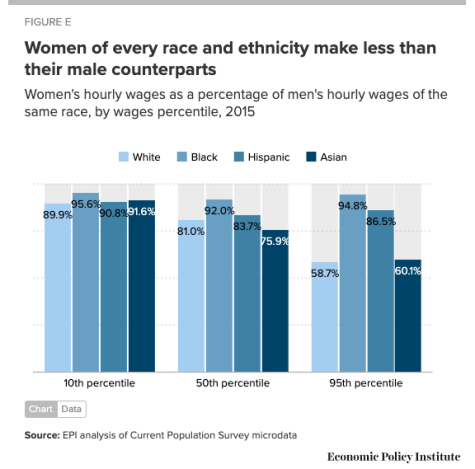
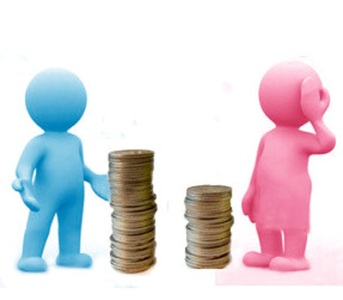
Sexism isn’t just seen within the wages of a workplace; many women don’t even get into men dominated careers or classes. White men dominate many occupations but some with the largest scales include Architectural and Engineering management, Aircraft pilots and Flight engineers, and Chief executives and Legislatures. Lower paying jobs see the opposite side with having a majority of women of all races, and men of color.
Workplace sexual harassment also contributes to these statistics as many women will resign from their jobs due to prioritizing their safety rather than their employment. These charts can be seen on the American Progress Report—Gender Matters. Women are heavily underrepresented in the government going back to the chart where you can see the domination in executives and legislatures, some find that if this were not the case more women’s issues would not be put on the back burner, as only 28% of Congress is women. This occupational segregation is rooted in social biases, for example women are commonly stereotyped to be caring and “motherly” so jobs such as a caregiver, teacher, or nursing may be a less discriminatory position. When women oppose this social norm by being in a leadership/authoritative position she is less likely to be taken seriously or even given the job in the first place.

In any job you can also see pregnancy discrimination. There have been two federal laws (one being the Pregnancy Discrimination Act of 1978) put in place to enforce this but these efforts still don’t prevent what is still currently happening. 1 in 5 mothers have reported experiencing pregnancy discrimination in their place of work. Further with this, over 1 in 5 mothers have been scared to even inform their employers of their pregnancy due to fear of discrimination, and nearly 1 in 4 partners report their wife experiencing some pregnancy discrimination. This may not seem like too big of an issue with such small statistics but the fact still stands that this is happening to a portion of women. If you are not a woman and don’t find this to matter, you should always ask yourself how you would feel if this was happening to your mother, your girlfriend, or your sister! This can happen and should be addressed.
Menstruation and Hygienic Stigma
While women are still paid less money than men, they are expected to spend more when buying products that are distributed by companies as “feminine.” Pink tax became a hot topic during the 1990s, the term being created to bring attention to higher prices put on products targeted towards women. This can be seen on various different hygiene products such as razors, shampoo, and deodorant which all also come in smaller portions compared to the men’s version. The name “Pink tax” came from the marketing scheme itself; selling a product which could be used by both men and women, but then selling that same product with pink packaging. In the end, the item will work the exact same, but traditionally—pink is associated with women, compelling them to buy it. With these prices in place, women have been shown to spend more on basic necessities like clothing, healthcare, and housing. This all comes without the mention of period products, very necessary items to have that are actually priced as luxury goods. On average, women spend $20 every menstrual cycle. Meaning that for those who have a period every month, they’ll be spending around $240 a year on products that are needed to keep up good hygiene. Just two years ago in 2021, the Menstrual Equality for All Act was passed to help fund schools, prisons, and homeless shelters to give out free period products.
Sexism seems to be brought up at a very young age and carried out to later stages of life. This could be because of what children hear from their parents or because of a blatant lack of knowledge provided in schools. 72% of boys were said to have not been taught anything about the menstrual cycle. With this absence of education, women have always been shamed and made to feel embarrassed about a completely natural and important function of their bodies. Growing up being ridiculed will eventually lead to damaging views a young girl might have of herself. 90% of girls skip school out of fear of getting their period without coming prepared, causing them to miss out on valuable education. This could also stick with a girl into their young adulthood. 1 of 3 women are said to avoid visiting their OBGYN. This could lead to the development of several different diseases, visiting your gynecologist shouldn’t be seen as embarrassing or trivial, but just as important as visiting any other doctor for a checkup.
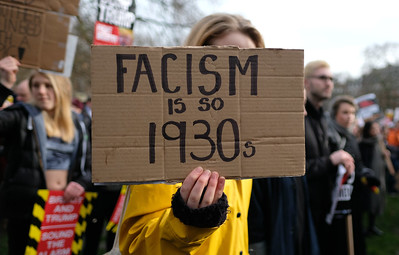
Periods aren’t the only thing seen as unhygienic though, body hair is also frowned upon and could bring disgusted looks from those around you if not kept to societal standards. To avoid rude comments, pre-teen girls use wax to rid themselves of body hair. The funny thing is, waxing is the only unhygienic part of all of this. Waxing causes irritation, ingrown hairs, and redness. Everytime you wax, another layer of skin is pulled off with it, leaving the area burnt or raw. Shaving isn’t much better either. The lipid layer of your skin (responsible for trapping moisture) is affected, leaving the area dry and vulnerable to irritants and other chemicals. But which one is better? Well—neither. Waxing however lasts longer since you’re pulling the hairs from the roots, leaving you with a few weeks of clear skin. Shaving only lasts a few days as you’re only getting the top layer of the hair. But ask yourself, does it really matter? Body hair protects you from bacteria, trauma, and keeps us warm. Nothing about it is unhealthy or anything other than what’s normal and natural. The choice to get rid of it is mainly on females. Most males are celebrated and praised for their hair growth and advocacy. Beards are branded as attractive and most men advocate to keep their hair as opposed to women who are pushed to remove their hair.
Silenced Assault
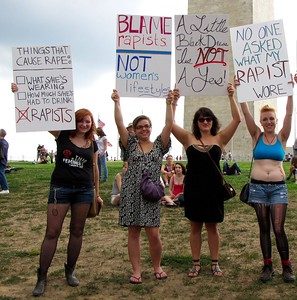
Sexual harrasment, rape, and sex trafficking are all issues that happen to women more in comparison to men. While these are all strong issues, many of them are overlooked. For example, from Ms. Magazine; 9 out of 10 victims of attempted or completed rape are women, but for every 100 instances of rape toward women, only 18 resulted in an arrest. 42 of these 100 cases were labeled as “inactive” by law enforcement and 30 more are closed due to “exceptional clearance.” Prosecutors commonly use these excuses when they don’t think they can win a case, so instead of going and trying to get more evidence, they just label the case and throw it out. Many rape kits aren’t even tested. These statistics are only one of many polls/data taken on this lack of justice. What makes this more troubling is that women are not very likely to receive help when going to the police, so most choose to stay silent. Universiy of Massachusetts – Lowell (UML) further states that fewer than 7% of rape and sexual assault cases make it over to police. It’s not just at random that attacks happen either, it’s reported that 8 out of 10 rapes are committed by someone that the victim knows and 33% of sexual violence is committed by a former intimate partner. These issues are thrown under the rug, especially if the crime is committed by someone the victim has had relations with.

Domestically women also experience a high percentage of abuse, domestic violence and other physical assaults. This is so prevalent for so many women every day and the way this is handled is not much better than the rape cases. Many women report feeling ignored by police when going for help in a domestically abusive situation. Further more, 1 in 4 women experience severe physical abuse, sexual abuse, or some sort of stalking situation within a relationship. This is most common for women between the ages of 18-24. More intense circumstances of this show that 9 out of 10 murdered women were killed by men they knew. Women are so commonly the victims of violence and it’s even more terrifying to consider the fact that so much of this is done by intimate relationships.
So please, before you try to comment on how much you know about what women endure, think about what you’ve just read. Ask yourself if you think these issues should be ignored further or if you should also talk about it, too.
Helpful Resources:
Child Protective Services (CPS): 301-600-2464 – Help for physical, sexual, emotional abuse or neglect.
Crisis Services: Dial 211 – Help when you feel really anxious or really depressed and need someone to talk with so that you can stay safe.
Crisis Text Line: Text HOME to 741741
Maryland Anonymous Tip Line: 1-833-632-7233 – Report threats or situations that put your safety, or others’ safety, at risk.
Suicide Prevention Hotline: 1-800-273-8255 – Help if you are thinking about suicide.
Pregnancy Risk Assessment Monitoring System (PRAMS): https://www.cdc.gov/prams/index.htm
Suicide Hotline: 1-800-273-8255
Your donation will support the student journalists of Brunswick High School. Your contribution will allow us to purchase equipment. Our goal is to purchase some updated and much needed cameras for the program.








